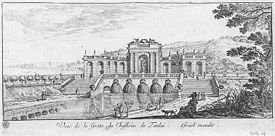
Château de Tanlay
Encyclopedia

Tanlay
Tanlay is a commune in the Yonne department in Burgundy in north-central France.-References:*...
(Yonne
Yonne
Yonne is a French department named after the Yonne River. It is one of the four constituent departments of Burgundy in eastern France and its prefecture is Auxerre. Its official number is 89....
) is a French château
Château
A château is a manor house or residence of the lord of the manor or a country house of nobility or gentry, with or without fortifications, originally—and still most frequently—in French-speaking regions...
built in Burgundy during the sixteenth and seventeenth centuries, famous for its beauty and the setting. The walls are of limestone under tall sloping slate roofs à la française, surrounding three sides of a central court with cylindrical towers at its four corners. The château is entirely encircled by its rectilinear moat
Moat
A moat is a deep, broad ditch, either dry or filled with water, that surrounds a castle, other building or town, historically to provide it with a preliminary line of defence. In some places moats evolved into more extensive water defences, including natural or artificial lakes, dams and sluices...
and approached on axis across a bridge marked by paired obelisk
Obelisk
An obelisk is a tall, four-sided, narrow tapering monument which ends in a pyramid-like shape at the top, and is said to resemble a petrified ray of the sun-disk. A pair of obelisks usually stood in front of a pylon...
s through a gatehouse (illustration) built in 1558, which straddles the low balustrade and projects forward into the moat. The perfect symmetry of the cour d'honneur
Cour d'Honneur
Cour d'Honneur is the architectural term for defining a three-sided courtyard, created when the main central block, or corps de logis, is flanked by symmetrical advancing secondary wings, containing minor rooms...
is part of Tanlay's serene charm.
The foundations are in part those of the thirteenth-century château-fort. The rebuilding in Renaissance
Renaissance
The Renaissance was a cultural movement that spanned roughly the 14th to the 17th century, beginning in Italy in the Late Middle Ages and later spreading to the rest of Europe. The term is also used more loosely to refer to the historical era, but since the changes of the Renaissance were not...
style is owing to the brother of the Admiral de Coligny, François de Coligny d'Andelot
François de Coligny d'Andelot
François d'Andelot de Coligny was one of the leaders of French Protestantism during the French Wars of Religion...
(1521-1569), who inherited the site in ruinous condition in 1547 and whose construction campaigns of 1555-1568 during the Wars of Religion
French Wars of Religion
The French Wars of Religion is the name given to a period of civil infighting and military operations, primarily fought between French Catholics and Protestants . The conflict involved the factional disputes between the aristocratic houses of France, such as the House of Bourbon and House of Guise...
, when Tanlay was a center of Huguenot
Huguenot
The Huguenots were members of the Protestant Reformed Church of France during the 16th and 17th centuries. Since the 17th century, people who formerly would have been called Huguenots have instead simply been called French Protestants, a title suggested by their German co-religionists, the...
resistance, left the residence uncompleted. Building was recommenced afterwards by Michel Particeli d'Hemery, the surintendant de finance under Mazarin, who completed the château to designs by Pierre Le Muet
Pierre Le Muet
Pierre Le Muet was a French architect famous for his book Manière de bâtir pour toutes sortes de personnes , and for the châteaux he constructed, most notably Tanlay in Burgundy, as well as some modest houses in Paris, the grandest of which, the Hôtel d’Avaux survives and has recently been...
between 1643 and 1649. Since 1700 the property has remained in the family of the man who was created marquis de Tanlay in 1705.

Trompe l'oeil
Trompe-l'œil, which can also be spelled without the hyphen in English as trompe l'oeil, is an art technique involving extremely realistic imagery in order to create the optical illusion that the depicted objects appear in three dimensions.-History in painting:Although the phrase has its origin in...
and for the frescoes in the Tour de la Ligue ("Tower of the Huguenot League"), in which the antagonists of the War are represented in the guise of Olympic deities, and for its mellow stone and its remarkable canal, moats and grounds, which include a nymphaeum
Nymphaeum
A nymphaeum or nymphaion , in ancient Greece and Rome, was a monument consecrated to the nymphs, especially those of springs....
or théâtre d'eau by Pierre Le Muet.

